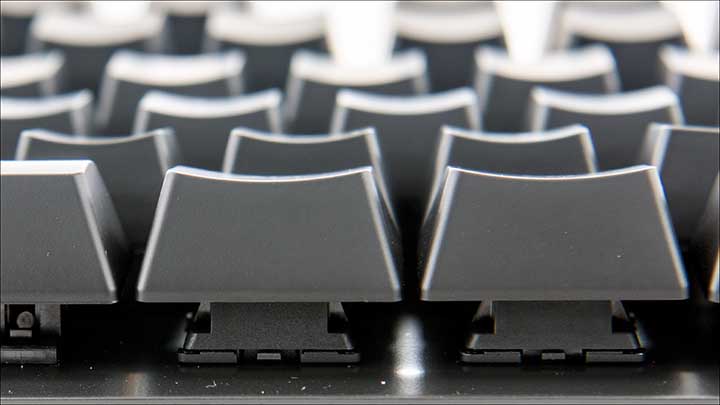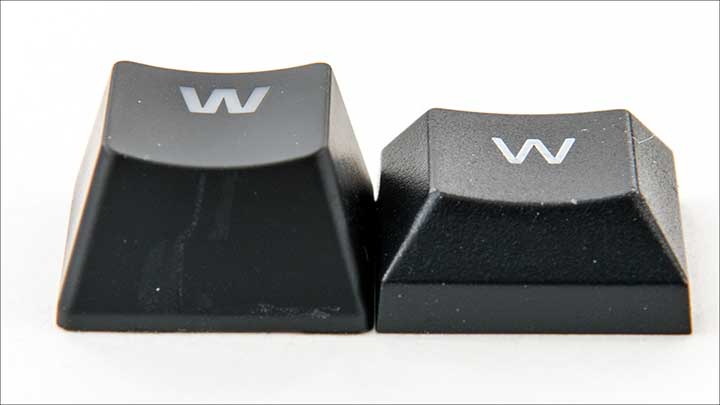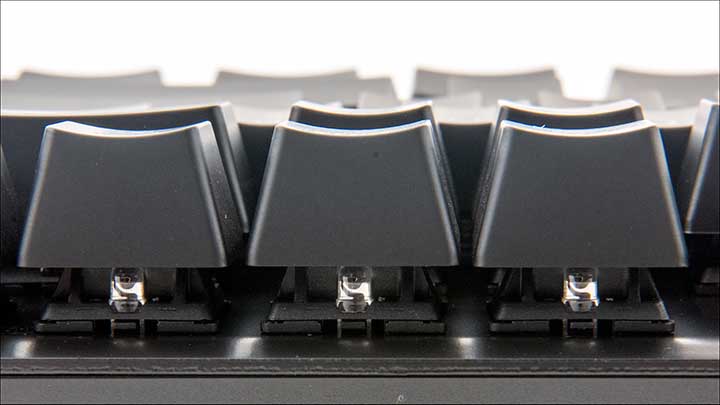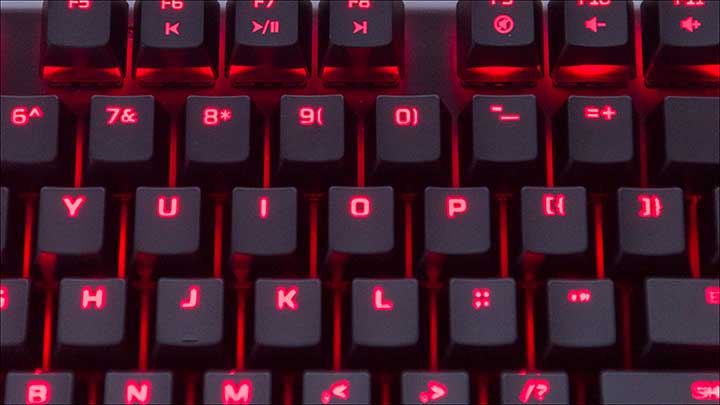The shipping container the Alloy FPS Pro comes in is classic HyperX through and through. This means that just like any of their other peripherals this TKL keyboard’s box is attractive and comes replete with all the information on it any potential buyer could want when making an informed purchasing decision. Further helping buyers out, especially those who do not know what TKL keyboard is, the top of the box has a large color image of the Alloy FPS Pro so that with just a glance you can get a good idea if this is the right keyboard for your needs.
Opening the box up you will be greeted with the keyboard in a plastic bag, while at the top a small cardboard tray. This tray contains the accessories which accompany this keyboard.
As expected, as this is a keyboard after all, the list of accessories is on the sparse side. In grand total you will get a nice corded mini-USB cable an instruction pamphlet, and a warranty card. What you will not find is any additional ‘gaming’ keys, a driver CD, nor a key puller. The lack of a CD is fairly self-evident as this keyboard does not need any drivers or software installed for it to function as it should. Instead the color adjustment and light adjustment features of this keyboard are built directly into it.
The lack of rubber topped W-A-S-D keys may indeed be disappointing to some, but honestly these keys are really nice for stock keys. We personally dislike having any key feel different than the rest when typing, but if you really want to have some keys be rubberized and the rest not, four rubber topped keys is not that big an expense. As we will get to in a moment swapping out and even all the keycaps for whatever you wish is not that difficult an endeavor.
Before we get to the HyperX Alloy FPS Pro we feel a little bit of background information is required. We are of course referring to the form-factor that the Alloy FPS Pro uses. TKL or ‘Ten Key-Less’ keyboards were created to fill a very specific requirement. That requirement was to offer consumers a smaller footprint without making the keycaps themselves smaller. The obvious solution was to remove the number pad portion of the keyboard (aka the ‘ten keys’) so that manufactures could offer buyers a keyboard that was about the same size as an 80% ‘board (where each key is only eighty percent the size of its ‘full size’ version) without making the keys smaller and harder to accurately type on.
As an added benefit TKL form-factors allow a keyboard to noticeably lighter than their full-size counterparts without reducing the actual underlying foundation- which is where the majority of the weight in a keyboard comes from. This too is a critical important as it allows a TKL to be light enough for travel but not any less robust. This really is a big deal as once you start lightening the back plate to reduce weight the keyboard will have a tendency to flex. This flexing first places added stress on each key switch and its electrical pathways and then causes them to fracture over time.
In other words TKL is an elegant solution to the old age problem of portability vs durability. It however is not without its downsides. The largest of which is obvious. If you use the number pad portion of a keyboard a lot… having to use the number row is less than optimal to say the least. As such the HyperX Alloy FPS Pro will not be right for everyone.
For those who do not mind the lack of the number pad section the Alloy FPS Pro is actually a great example of what can be obtained for very little money. Not only does this keyboard cost less than the average ‘full size’ keyboard, and is lightweight (without being flimsy) it is downright low-profile in its design. Ask any mechanical keyboard user about keycap profile height and you will get basically one of two answers. Those that prefer the ‘OEM’ keycap height and those that prefer the ‘Cherry Profile’. We personally fall into the latter camp as while OEM keycaps are indeed taller (but easier to install noise and vibration dampening o-rings on) the cherry ‘low profile’ keycaps not only make for a nicer, cleaner looking ‘board they are also easier to go from using a mushroom dome based keyboard to mechanical.
This last bit is, in our opinion, one of the most overlooked considerations when choosing a new keyboard. There is always a ‘break in’ period where users have to get used to the feel of a new keyboard and for many the change from mushroom dome switches to mechanical key switches is rather steep. So steep that not everyone is willing to spend weeks getting used to the different feel and different hand positioning – remember when a keyboard is taller but everything else stays the same all that muscle memory in typing is thrown out by your brain and you have to learn how to position your hands and forearms all over again.
In this regards HyperX has taken a rather unique approach. On the one hand they have opted for standard height keycaps but on the other the actual design of the keyboard is extremely low. The end result is a keyboard that offers the best of both worlds. One that is easy to upgrade and easy to adjust too.
Equally important is the HyperX Alloy FPS Pro uses standard OEM profile keycaps that are not only OEM height but also use OEM dimensions. This means that if you do not like the ABS keycaps that HyperX has opted for you can swap them out for any aftermarket solution you want when you realize that ABS is inferior to PBT. This is not something everything mech ‘board can do. For example Corsair uses odd-ball sized bottom row keycaps that are a nightmare to source out. Though to be fair while the HyperX Alloy FPS Pro’s keycaps are indeed made from ABS and not PBT they are rather comfortable to type on.
Basically, while they do have OEM dimensions the top of each key cap is not your typical OEM style. Each key caps top (i.e. the part your fingers actually touch) have been designed with a nicely rounded edge but rather deep slope to them. This combination means that they are gentle on your fingers while still correcting a slight off center hit. The end result really cannot be described as your typing speed will go up, your typing errors will go down… and your fingers will not be sore from this gentle persuasion.
The second unique design option is that even though these keycaps are standard height the overall height of the keyboard is significantly lower than the average Cherry switch based design. So much so that the overall height of this ‘board is basically the same as a low-profile keycap equipped keyboard. For example our Cherry MX Board 3 is about the same height as the HyperX Alloy FPS Pro and yet uses standard height keycaps! This design really is brilliant, though there is a bit of a downside and certain compromises have to be accepted.
The first of these is the back plate (the portion of the frame that the key switches are attached to) and overall construction of this keyboard does edge more towards the ‘less robust’ end of the spectrum and not the ‘battle tank’ end. When the keyboard’s two feet are engaged, and the back half is raised there is a small but sometimes noticeable flex that occurs during high-speed typing sessions. It is not enough to be worrisome, and is all but a non-issue when the HyperX Alloy FPS Pro is sitting flat on a desk, but experienced mech ‘board users will feel this flex and have concerns over longevity. We personally feel that the flex is minor enough to not be an issue, but some will feel differently. Basically, if there is ever a zombie apocalypse and we feel the need to use a keyboard as a melee weapon we will be reaching for our $300 Cherry MX Board 3, but in normal (aka realistic) scenarios it is not that big a deal and the benefits to this design outweigh the negatives.
Another small but noteworthy design compromise is the Cherry key switches that HyperX has opted for. No we do not mean the Cherry MX-Red key switch -as the Alloy FPS Pro comes in Blue, Brown or Red all of which are rated for 50 million actuations. We personally prefer ‘reds’ as they are a nice all round switch that works equally well in typing centric scenarios and PC Gaming scenarios as they have a long actuation point but no click or tactile feedback. Some however want tactile feedback when the switch is activated so Brown would be a more suitable option. Others want an audible ‘click’ sound when the keys witch is activated so as to avoid bottoming out the key. We personally are button mashers when gaming, and always install O-rings so that bottoming out is not a big deal when typing. You may feel differently in which case a good Cherry Blue switch for your typing keyboard may be a more optimal solution.
Regardless of which option you choose rest assured that it is only the feedback of the switch, and pressure required for activation that differs. All have 4mm total travel length and the switch activates at the 2mm point. Blues are simply ‘clicky’ and require a moderate 50cNs, while ‘bumpy’ Browns and silent & smooth red’s require only 45cN. If you have never used Cherry stitches before think of the Blues as a more modern analog to an old typewriter (in that they are heavy and loud) so they are not perfect for FPS scenarios as rapidly pressing the button is a touch more difficult. Reds are at the other end of the spectrum and are completely silent… until you bottom them out and they ‘bang’ against the metal frame. Some, such as ourselves prefer Red for general purpose rigs as they may not be as nice as Blues for typing but they are still good at it and are much better for gaming.
Browns are best considered a compromise design in that they give tactile feedback for typing (there is literally a little bump felt when the switch is activated) but can be activated a lot faster than Blues in gaming scenarios and when you get used to the bump you can just hover the switch just above its activation point for even faster response speed in button mashing games. Basically there is no single switch that will be right for everyone but we would recommend Browns for first times buyers as this compromise design is a safe bet until you know exactly what you want from your keyboard.
When we say that there are design compromises baked right into the Allow FPS Pro what we mean is that HyperX is using the older Cherry MX LED key switches and not the newer RGB version. In practical terms this means that the HyperX Alloy FPS Pro is only capable of one color, red, and not millions of color combinations. We personally do not care as long as the keyboard is backlit but if you want a rainbow waterfall effect or similar eye catchy color combinations it may not be an optimal choice. The other issue with Cherry MX LED switches, and a big reason why Cherry redesigned it along with the LED used when they made the Cherry MX RGB series, is the amount of backlight bleed is noticeable in darker environments.
On the positive side the backlight is not severe at all but maximum light intensity and you can easily adjust the light intensity of the LEDs. You can even customize which ‘glow’ and which will not, all without installing any software. Instead simply press the Function key and up or down arrow key to adjust the light intensity, the Function and left or right arrow key to cycle through the lighting modes (e.g. wave, breathing, etc), and function with right control button to adjust which keys will light up. For the latter all you do is enter the onboard customization via that key combination… and then press each key you want to light up. If you make a mistake or change you mind… press it again. Then exit and bam custom lighting. Of course if you change your mind and want to adjust things all you need do is enter this key-press combination and you are off to the races. This really is the way all keyboards should be adjusted as we dislike relying on external software solutions that can malfunction.
The second last issue is the lack of dedicated ‘multimedia’ keys. These options are there but you have to use the function key and press the corresponding key to get the desired result instead of (e.g.) turning a wheel to decrease/increase volume. Some will find this to be a major negative, others not so much. Only you can decide if it is or is not an issue. What all will find to be a major positive however is you get a very well rounded, feature packed, low profile without being actually low-profile keyboard for only $75. That is less than what many mushroom dome / fail if you look at the keyboard wrong models from other manufactures cost. That in and of itself is a feat worthy of Cherry themselves and is bloody amazing for a relative newcomer to pull off. Maybe the old adage that ‘young and hungry’ companies truly are the ones who think outside the box to push the market forward.
The last issue is more of a non-issue in that the Alloy FPS Pro’s mini-USB is on the top leading edge of the keyboard and as such there is no integrated cable management system. Instead the mini-USB cable sticks out the ‘back’ of the keyboard. To us this actually makes things easier during setup but it does make for a slightly more cluttered looking keyboard. The reason for this design decision is simple… there was simply no room on the underside for molding in runs or pathways for the cable – nor even room to place the USB port anywhere but on the edge of the keyboard! Basically if HyperX wanted a keyboard as low profile as possible this typical feature had to be left on the cutting room floor.
Overall the design of the Alloy FPS Pro is definitely unique and we must admit that it is unique in a good way. A way where changes were made not just for the sake of change but because of logical decisions by the design team to satisfy the desired design priorities… now if they only had not made it a floating design and actually covered the key switch plate and we would be really impressed. This is because floating designs may look cool and all, but more dirt, lint, and dust does seem to make its way to the key switches when there is no ‘top plate’ to act as a dust cover. Now admittedly this is personal preference so you may feel differently. You may prefer ease of cleaning to the more classic look of most keyboards that simply don’t get dirty enough to clean in the first place.






















